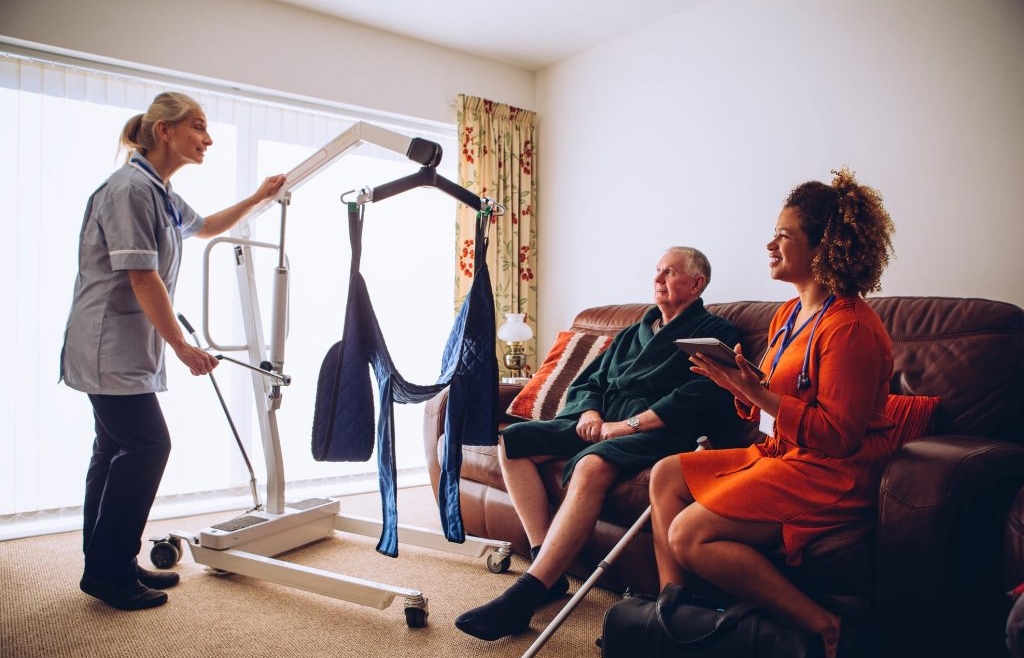Did you know that Leading Edge Senior Care has a Dementia Support Group? We meet monthly in Mesa. For more details <click here>
Senior Hoyer Lifts for In-Home Care
Senior Hoyer lifts for in-home care. Too many family caregivers attempt to move and shift seniors with little to no mobility by themselves, endangering both their health and the seniors. Back injuries, chronic pain, and falls often result from trying to manually lift someone. There are devices that can help make these daily tasks easier and safer for all those involved in a senior’s care–the best part is that Medicare Part B covers them.
When Are Lifting Devices for Seniors Appropriate?
For seniors with very little mobility, who have trouble balancing and are not strong enough to sit or stand up, it is recommended that they use a mechanical lift. This piece of senior care equipment would be especially beneficial for those wanting to age in their current home.
Cognitive Status
A senior’s cognitive status is an important consideration as well. For example, one might think that a senior’s functional abilities would negate the need for a mechanical transfer. But, if this person has a neurological condition that prevents them from comprehending directions and/or physically following them, then transfers may be best completed using a senior care lift–this is often the case for seniors with moderate to severe Alzheimer’s disease or Parkinson’s disease, or other neurological conditions that affect cognition and motor function like stroke.
Not only do lifts benefit those being cared for, but they also help caregivers. In fact, many times when caring for a loved one at home, the caregiver attempt transfers without any additional help or equipment–even though it’s needed. Overexertion injuries are unfortunately common among family caregivers and can cause chronic health problems and pain down the road if not careful. For seniors, improper repositioning and transfer techniques can result in serious Fall-related injuries–such as head trauma, fractures, etc.–and even death in some cases.
In fact, transfers are such a risky activity for seniors and caregivers alike that Leading Edge Senior Care implement strict rules on the level of assistance they can provide and policies for how transfers should be done. Once a senior’s mobility declines, we will usually recommend implementing a Hoyer lift to ensure safety for both the caregiver and senior.
Types of In-Home Senior Care Lift Assist Devices
Senior lifts come in manual and electric varieties. Manual models use hydraulic power; electrical options either use rechargeable battery power or plug directly into an outlet. Electric models are more expensive but require less exertion from caregivers, making them extremely convenient.
There are other critical elements you must take into account when picking a senior care lift such as the maximum lifting height of the device (some can hoist a person off the ground while others may only go as low as a bed or chair), and their weight limit (bariatric or heavy-duty models can support heavier individuals and they’re usually electric). Plus, you need to decide how many people are needed to use the lift safely. Some devices allow for one person to operate them, while others necessitate at least two people to handle both the senior and running the lift simultaneously.
Four of the most common types of senior care lifts are explained below.
Sit-to-Stand Lifts
Also known as “stand assist lifts” and “stand up lifts,” these models help seniors who can sit up independently and bear some weight but are unable to safely transfer from sitting to standing (and vice versa) on their own. Sit-to-stand lifts allow a person with limited physical abilities to continue exercising their remaining mobility and maintain their quality of life. When elders find themselves in this type of situation, they often lose confidence in being able to move around freely. They may resign themselves to using a wheelchair or being bedbound, which only negatively impacts their strength and balance further.
Floor-Based Sling Lifts
A Hoyer lift is a device that helps with transfers and transport for those who are mobility-impaired. It has a wide, wheeled base and looks somewhat like a crane. The term “Hoyer” actually refers to the brand name of one well-known manufacturer. However, there are many other companies that make this type of product. When selecting a floor-based full-body sling lift, you should keep in mind the tasks it will be used for. Plus whether or not it will fit through doorways and walkways in the senior’s home.
Overhead Sling Lifts
Electric ceiling lifts use permanently mounted overhead track systems. Freestanding overhead tracks to transfer seniors, which is much more efficient than a floor-based model. Because they don’t take up as much space on the floor or in storage. Electric ceiling lift models are optimal for small rooms or tight spaces.
Types of Senior Lift Slings
There are many styles of lifts available on the market. Each is designed to meet different needs. In addition, various slings can be purchased to further customize a setup. Slings are the fabric components that wrap around a senior’s body and attach to the lift. There are full-body slings that offer upper-body and head support. These slings have extra padding and specialized slings for bathing and commode use. Be sure to check the size and weight ratings. Read recommended care instructions, comfort, and functionality of the sling you choose to help with your loved one’s transfers. Also, make sure it is compatible with your lifting device and needs.

